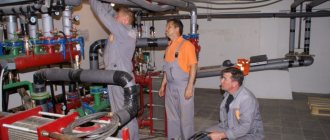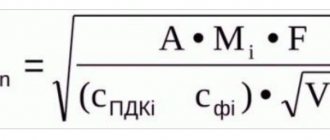Adjusting heating batteries in an apartment allows you to simultaneously solve several problems, among which the main one is to reduce the cost of paying for some utilities.
This possibility is realized in different ways: mechanically and automatically. However, changing the parameters of the heating system does not increase the average room temperature. You can only reduce it to the desired level by adjusting the position of the valve. It is advisable to install such devices on batteries in houses where it is cool in winter.
Why do you need to adjust
The main factors explaining the need to change the heating level of batteries using locking mechanisms, electronics:
- Free movement of hot water through pipes and inside radiators. Air pockets can form in the heating system. For this reason, the coolant stops heating the batteries, since it gradually cools. As a result, the indoor climate becomes less comfortable, and over time the room cools down. To keep the pipes warm, shut-off mechanisms installed on the radiators are used.
- Adjusting the temperature of the batteries makes it possible to reduce the cost of heating your home. If the rooms are too hot, changing the position of the valves on the radiators can reduce costs by 25%. Moreover, reducing the heating temperature of the batteries by 1 ° C provides a savings of 6%.
- In the case when the radiators strongly heat the air in the apartment, you often have to open the windows. In winter, it is inappropriate to do this, since you can catch a cold. In order not to constantly open windows in order to normalize the microclimate in the room, regulators should be installed on the batteries.
- It becomes possible to change the heating temperature of the radiators at your own discretion, and individual parameters are set in each room.
How to regulate radiators
To influence the microclimate in the apartment, it is necessary to reduce the volume of the heat carrier passing through the heater. In this case, it is only possible to lower the temperature value. The heating system is adjusted by turning the valve / tap or changing the parameters of the automation unit. The amount of hot water passing through the pipes and sections is reduced, at the same time, the battery heats up less intensely.
To understand how these phenomena are interrelated, you need to learn more about the principle of operation of the heating system, in particular, radiators: hot water entering the inside of the heater heats the metal, which, in turn, gives off heat to the air. However, the intensity of heating the room depends not only on the amount of hot water in the battery. The type of metal from which the heater is made also plays an important role.
Cast iron has a substantial mass and slowly gives off heat. For this reason, it is impractical to install regulators on such radiators, since the device will take a long time to cool. Aluminum, steel, copper - all these metals instantly heat up and cool down relatively quickly. Work on the installation of regulators should be carried out before the beginning of the heating season, when there is no coolant in the system.
In an apartment building, it is not possible to change the average value of the water temperature in the pipes of the heating system. For this reason, it is better to install regulators that allow you to influence the indoor climate in a different way.However, this cannot be realized if the heating medium is supplied from top to bottom. In a private house there is access and the ability to change the individual parameters of the equipment and the temperature of the coolant. This means that in this case it is often inappropriate to mount regulators on batteries.
Where to install?
The fact that the installation must be carried out in an apartment (in an apartment building) is not discussed, but where exactly and how we will now consider it. According to SNiP, if the fluid flow is provided not with the help of a pump, but due to the temperature difference, the heating system is mounted at a slope.
The slope is obligatory from the side of the incoming hot coolant in the direction of its outlet.
The correct heating system will avoid the constant formation of an air lock.
Most often, radiators are installed on the end walls (if any) or under windows, because it is through them that cold air enters the room.
Installation of bimetallic radiators, aluminum and cast iron, according to SNiP, is carried out according to the diagram below.
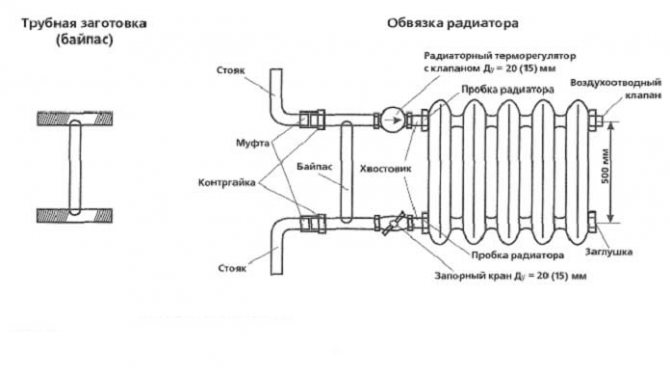
According to the same SNiP, the pipes that supply the coolant to the radiator must be mounted at an angle of 0.005 - 0.01, in other words, the deviation of the pipeline should be 0.5 - 1 cm, per meter.
The installation of aluminum, cast iron and bimetallic radiators requires adherence to the installation instructions, this will ensure natural convection.
It is also possible to increase the efficiency of our system by sticking a heat reflector on the walls in the places where radiators are installed.
Valves and taps
Such fittings are the heat exchanger of the shut-off device. This means that the radiator is adjusted by turning the tap / valve in the desired direction. If you turn the valve to the stop by 90 °, the water flow into the battery will no longer flow. To change the heating level of the heater, the locking mechanism is set to the half position. However, not all fittings have such an opportunity. Some valves may leak after a short time in this position.
Installing shut-off valves allows you to manually adjust the heating system. The valve is inexpensive. This is the main advantage of such fittings. In addition, it is easy to operate, and no special knowledge is required to change the microclimate. However, there are drawbacks to locking mechanisms, for example, they are characterized by a low level of efficiency. The battery cooling rate is slow.
Shut-off valves
A spherical design is used. First of all, it is customary to install them on a heating radiator in order to protect housing from coolant leakage. Valves of this type have only two positions: open and closed. Its main task is to disconnect the battery if such a need arises, for example, if there is a risk of flooding the apartment. For this reason, stopcocks are cut into the pipe in front of the radiator.
If the valve is in the open position, the coolant circulates freely through the heating system and inside the battery. These taps are used if the room is hot. The batteries can be disconnected from time to time to reduce the room temperature.
However, ball valves must not be installed in the half position. With prolonged operation, the risk of a leak in the area where the ball valve is located increases. This is due to gradual damage to the ball-shaped closure that is located inside the mechanism.
Manual valves
This group includes two types of fittings:
- Needle valve. Its advantage is the possibility of half-installation.Such fittings can be located in any convenient position: completely opens / closes the access of the coolant to the radiator, significantly or slightly reduces the volume of water in the heating devices. However, there is also a drawback to needle valves. So, they are characterized by a reduced bandwidth. This means that after installing such a valve, even in a fully open position, the amount of coolant in the pipe at the battery inlet will be significantly reduced.
- Regulating valves. They are specially designed to change the heating temperature of the batteries. The pluses include the ability to change the position at the discretion of the user. In addition, such fittings are reliable. You will not have to frequently repair the valve if the structural elements are made of durable metal. There is a shut-off cone inside the valve. When the handle is turned in different directions, it rises or falls, which contributes to an increase / decrease in the flow area.
Automatic adjustment
The advantage of this method is that there is no need to constantly change the position of the valve / tap. The required temperature will be maintained automatically. Adjusting the heating in this way makes it possible to set the desired parameters once. In the future, the heating level of the battery will be maintained by the automation unit or other device installed at the input of the heater.
If necessary, individual parameters can be set multiple times, which is influenced by the personal preferences of the residents. The disadvantages of this method include the significant cost of components. The more functional devices are for controlling the amount of coolant in heating radiators, the higher their price.
Electronic thermostats
These devices look like a control valve, but there is a significant difference - a display is incorporated in the design. It displays the room temperature to be obtained. Such devices work in tandem with a remote temperature sensor. It transmits information to the electronic thermostat. To normalize the microclimate in the room, you just need to set the desired temperature value on the device, and the adjustment will be performed automatically. They have electronic thermostats at the battery inlet.
Radiator control with thermostats
Devices of this type consist of two units: the lower (thermo-valve) and the upper (thermo-head). The first of the elements resembles a manual valve. It is made of durable metal. The advantage of such an element is the ability to install not only an automatic, but also a mechanical valve, it all depends on the needs of the user. To change the value of the heating temperature of the battery, the design of the thermostat provides for a bellows that exerts pressure on the spring-loaded mechanism, and the latter, in turn, changes the flow area.
Using three-way valves
Such devices are made in the form of a tee and are designed to be installed at the connection point of the bypass, the inlet pipe to the radiator, and the common riser of the heating system. To increase the efficiency of the operation, the three-way valve is equipped with a thermostatic head, the same as that of the previously discussed thermostat. If the temperature at the inlet to the valve is higher than the desired value, the coolant does not enter the battery. Hot water is directed through a bypass and further through the heating riser.
How to determine if the temperature of the water in the radiators is below normal?
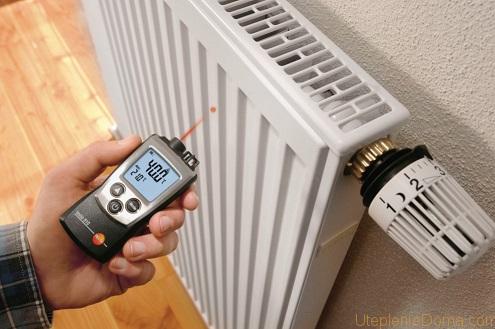

A device that measures the surface temperature with a beam.
Heating quality is often determined by the room temperature. If you feel that the rooms are cool, you need to measure the temperature. The maximum allowable is +18 degrees. If it is lower, then you need to identify the cause.The main reasons may be through windows and doors, but more important - the low temperature of the water in the radiators.
To determine what should be the temperature of the batteries in your apartment, there are special calculations. They are compiled by specialists who compare the temperature of the water in the radiators and the ambient temperature. It is necessary to call a special service that will measure the temperature in the heating radiators in your apartment. The data obtained are compared with the data on the temperature graph. In this graph, it has already been calculated what temperature should be in the pipes of the direct water supply and return.
Table. Temperature graph of the ratio of heating to ambient temperature.
| Ambient temperature | Direct water supply temperature | Return water temperature |
| -15 | 105 | 70 |
| -10 | 92 | 63 |
| -5 | 78 | 56 |
| 0 | 65 | 48 |
| +5 | 50 | 39 |
These data are given for a one-pipe heating system, with water supply from the bottom up. According to the table, when the air temperature outside, for example, -10 degrees Celsius, the water temperature on the return should be at least 63 degrees. And this does not depend on whether the measurements are taken on the first or fifth floor. In a two-pipe heating system, the water temperature at -15 outside is allowed 95 degrees on a direct water supply.
Each settlement has its own temperature schedule. It is approved by the city administration.
If the temperature of the battery in the apartment is below normal, then this means that the boiler room saves on heating. After measuring the water, the specialists draw up an act, and the utilities must fix all the problems. At the same time, everyone has the right to demand recalculation of the heating fee. The rent should decrease according to the square of the apartment. The temperature of the water in the radiators is one of the main factors in a warm home. According to the standards for the temperature of the batteries in the apartment, a coolant must be supplied, the degree of heating of which ranges from 80-85 degrees.
It is very simple to make heating with heating elements in your home, while each heat exchanger will not depend on others. To do this, it is enough to screw the heating element into the lower end of the battery and connect it to the mains.
Here you will find everything about infrared heating of a private house: reviews, calculations and drawings.
Installation recommendations
In order to be able to regulate the temperature of the battery in the apartment, any type of valves is considered: they can be of a straight or angle type. The installation principle of such a device is simple, the main thing is to correctly determine its position. So, the direction of the flow of the coolant is indicated on the valve body. It should correspond to the direction of movement of water inside the battery.
Valves / thermostats are located at the inlet of the heater, if necessary, they also cut in the tap at the outlet. This is done so that in the future it will be possible to independently drain the coolant. Regulating devices are installed on radiators, provided that the user knows exactly which supply pipe, since a tie-in is made into it. In this case, the direction of movement of hot water in the riser is taken into account: from top to bottom or from bottom to top.
Compression fittings are more reliable, so they are used more often. The connection to the pipes is threaded. Thermostats can be equipped with a union nut. FUM-tape, flax is used to seal the threaded connection.
If a correctly calculated autonomous heat supply is functioning in the house, then adjustment will not be required for the heating batteries, since a stable temperature regime will be ensured in all rooms. But in multi-apartment buildings, where residents often redesign heating systems, regulators will not interfere.Also, it will not be superfluous to install a common house heat meter in an apartment building, which will save residents' funds.


Where to begin?
Before proceeding with the selection of bimetallic, cast-iron or aluminum radiators with their further installation, it is necessary to prepare and at least study the theory and familiarize yourself with those paragraphs of the SNIP that relate to this type of work.
Additional viewing of the training video will not be superfluous.
Video:
First, let's determine what kind of heating scheme is used in your home.
According to SNiP, there are two schemes for installing heating systems in an apartment building:
- The scheme of a one-pipe installation of a heating system is inherent in most apartment buildings of an old building, which are powered from a centralized heating system;
- The scheme of a two-pipe installation of a heating system, as a rule, is found in modern houses and houses with individual heating.
The need to adjust heat transfer
There are two reasons why regulation of heating radiators is required:
- Reducing the cost of heating your home. True, in an apartment located in a multi-storey building, it is possible to reduce the amount of payments only if there is a general house heat meter. In a private household, in the case of installing an automated boiler, the installation of regulators is unlikely to be required. The amount of savings will be significant.
- The presence of the need to maintain the desired temperature regime in the premises. For example, in one room it may be 17 degrees Celsius, and in another - 25 degrees. To do this, you need to set the appropriate numbers on the thermal head or close the valve.
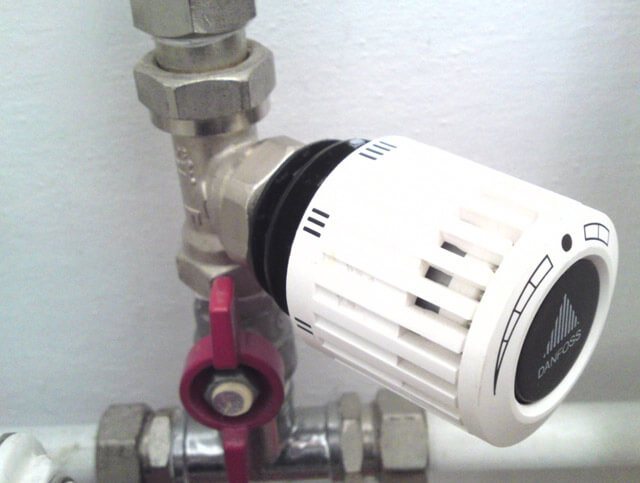

At the same time, it does not matter how the heated coolant enters the radiators - centrally or autonomously. It also does not matter which heating unit is installed in the system. The fact is that the regulators on the batteries are not connected with the boilers - they function independently.
Adjusting heating radiators
To understand the question of how to regulate heating batteries with a regulator, first of all, you should find out the principle of their functioning. By its design, the radiator consists of a labyrinth of pipes and fins of various types, providing increased heat transfer.
Hot liquid enters the inlet of the device, passes through the labyrinth and thereby heats the metal, which gives off heat to the surrounding air. The fins on modern radiators are made of a special shape, which improves the convection of air flows, and the room is heated quickly.
In the case of active heating from the batteries, a heat flux is felt. This means that when the amount of heat carrier passing through the device changes, it is possible to adjust the room heating temperature, albeit within certain limits.
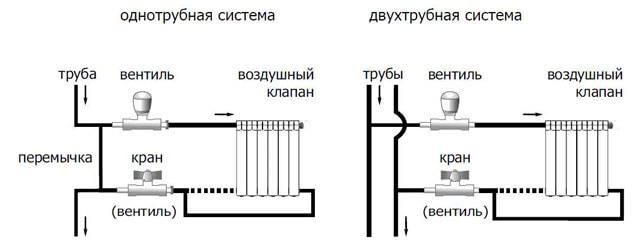

This is what special fittings are intended for - thermostats and valves. But the heating regulator installed on the battery in the apartment is not able to increase heat transfer, it can only lower it.
The efficiency of changing the battery temperature depends on:
- on whether there is a power reserve for heating devices;
- on the correct selection and installation of regulators.
Of no small importance is the inertia of the entire heat supply system and the batteries themselves. For example, cast iron, which is characterized by a large mass, changes temperature slowly, while aluminum heats up quickly and cools down the same way. This means that there is no point in cast-iron radiators with temperature control, since the result from this has to wait for a long time.
Reasons for the lack of heat in the apartment
Situations are possible when, due to the negligent attitude of the heat supply company to its own duties, the supply of heat to the apartments does not occur. Why? The reasons for the lack of heat include:
- Breakdown of the heating system of the house;
- Filling of pipes conducting heat into houses with air;
- Unfinished renovation work.
If the delay in heating supply is caused by a breakdown in the building system, then it is impossible to correct the situation until the problem is eliminated.
If the reason for the delay is in the filling of the heat supply pipes with air, it is necessary to contact the operating organization. The specialist must “blow through” the batteries within 24 hours after treatment, and there will be no obstacles to filling them with circulating liquid.
Ways to increase heat transfer from batteries
The presence / absence of the possibility to increase heat transfer depends on the calculation of the power reserve of the radiator. If the device is not able to produce more heat energy, then no fittings will help.


You can try to change the situation in one of the following ways:
- First of all, you should check if the filters and pipes are clogged. Blockages form both in old buildings and in new buildings, since various construction waste gets into the system. When cleaning does not work, you need to take drastic measures.
- Increase in coolant temperature. This can be done in the presence of autonomous heating, but it is unlikely with centralized heating.
- Replacing the connection type. Not all battery connection methods are created equal. For example, a reverse side connection results in a power loss of about a quarter. Also, the place of installation of the device affects the heat transfer.
- Increasing the number of sections. If the location and method of connecting the radiators are chosen correctly, and the room is also cold, this means that the thermal power of the devices is not enough. Then it is necessary to increase the number of sections.
If the heating system is equipped with temperature-controlled batteries, then they require a certain amount of power and this is their main disadvantage. As a result, the cost of arranging heating increases, since each section costs money.
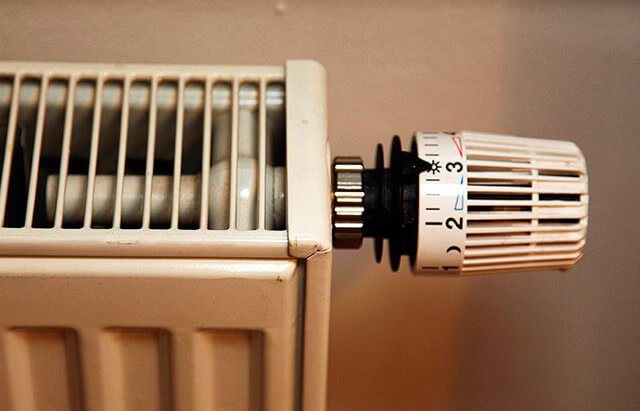

Comfort cannot be achieved if the room is cold or too hot, therefore heat regulation in radiators is a universal solution to this problem.
There are many devices on the market that are designed to change the volume of the coolant passing through the radiator. Among them there are both inexpensive and high-cost products. They come with different adjustments: manual, electronic and automatic.
Ways to change the temperature with radiators
The first way to adjust the temperature of radiators in a room is when you have one radiator in your room and it is covered by a screen. In this case, we will regulate the temperature in the room using a room thermostat and a servo drive.
First, select the installation location for the room thermostat. Usually it is located 1 meter from the door. At a height of 1 to 1.5 meters on the opposite wall from the door handle, so that when the door is opened, the flow of cold air hits the thermostat, and that in turn immediately reacts to the temperature drop.
On the supply pipe of the radiator, we mount a valve under the thermal head, onto which we screw the servo drive for heating systems.
The servo needs a 220 volt power supply. In this case, its power is 2-3 watts. We lead the cable from it to the room thermostat.
Room thermostats are divided into two groups: electronic and mechanical. Mechanical thermostats nowadays have practically outlived their usefulness, but they are the easiest to install. They work like a conventional switch. Bring power to the thermostat. Through it you break the phase to the servo and that's it. The thermostat supplies power to the servo drive or not.
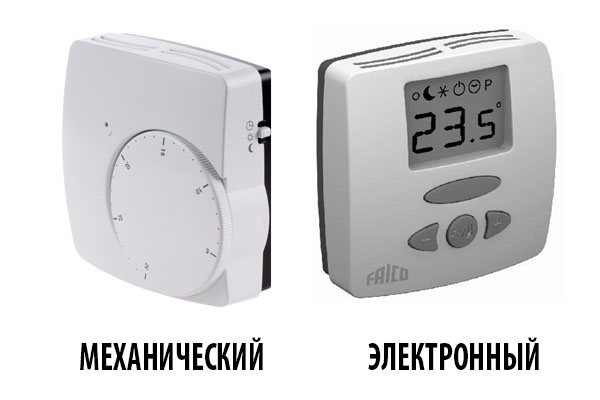

Electronic thermostats are simple, in terms of turn on turn off, and there are programmable thermostats.
In turn, electronic thermostats are of two types according to the principle of operation:
The first are thermostats that require mains power to operate. Usually 220 Volts. That is, they are supplied with food separately. And from the thermostat, a cable is separately mounted to the servo.
The second type of thermostats does not need power from the mains, since such thermostats are equipped with a battery. In this case, as with mechanical thermostats, the phase to the servo is simply broken through it, and zero goes to the servo without breaking. In this case, all thermostats must be connected in the switchboard to your machine for quick replacement or maintenance.
Ball Valves
The valves are cheap, but at the same time ineffective regulating devices. Ball valves are often installed at the inlet to the radiator, with the help of which the water flow is regulated.
But this equipment also has a different functionality - shut-off valves. Valves are used to completely shut off the flow of coolant in the system. For example, in the event of a heater leak, ball valves located at the inlet and outlet of the radiator allow repairs to be carried out without stopping the heat supply and draining the liquid.
Ball valves do not regulate heating batteries in the apartment. They have only two positions - completely closed and open. The intermediate location only brings harm.
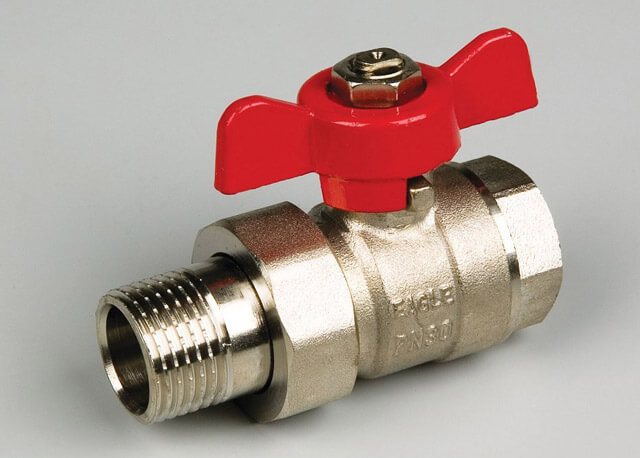

The fact is that inside such a faucet there is a ball with a hole, which in its normal position is not threatened, but in all other situations the solid particles present in the coolant grind it off and pieces break off from it. As a result, the tap will not be sealed and in the "closed" position water will continue to flow into the battery, which is fraught with big troubles in the event of a leaking device.
If one of the property owners decided to do everything to manage the radiators using ball valves, it must be remembered that they must be installed correctly.
This method is usually used in apartment buildings. If the wiring is single-pipe vertical, then a hot water pipe enters the room through the ceiling and a radiator is connected to it (read: "Correct adjustment of heating batteries in an apartment - comfort in the house and saving money"). The pipeline leaves the second entrance to the device and goes through the floor to the room below.
In this case, it is necessary to correctly install the valves, since the installation of a bypass is mandatory. The bypass pipe is needed so that when the liquid flow to the radiator is closed, the coolant continues to circulate in the common house system.


In some situations, the tap is located on the bypass in order to change the amount of water passing through it and thereby adjust the heat transfer of the battery. To ensure greater reliability of the heating system, at least three taps are installed: two will be cut-off on the radiator and operate normally, and the third will become regulating.
Methods for adjusting the heating system
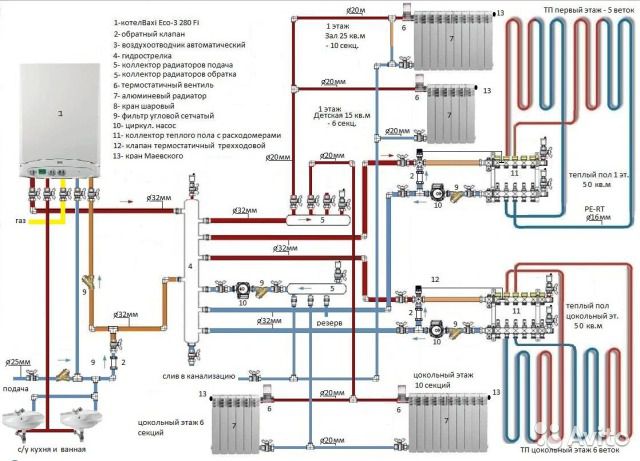

Heating system with control valves
There are several ways to change the characteristics of heat supply. Timely hydraulic adjustment of the heating system is necessary to stabilize the pressure in certain areas and the entire circuit as a whole. Temperature correction serves as a tool for changing the degree of heating of the air in a particular room. Most often, a tap is used for this to adjust the heating temperature.
All of the above characteristics largely depend on the operation of the boiler. However, to normalize the system parameters, additional components must be installed. Depending on the function, they are divided into the following types:
- Temperature... They are used to partially or completely shut off the coolant flow in radiators or in a separate circuit. With the help of taps, a thermostat or mixing units, the heating batteries in the apartment are adjusted;
- Pressure... Temperature differences between flow and return can cause pressure surges. This will imbalance the system, which will impair its performance. To eliminate this problem, hydraulic switches are mounted, as they do the collector piping.
In practice, timely adjustment of valves on radiators reduces energy costs. Also, using the adjusting fittings, you can change the degree of heating of the air in the room.
The actual performance of the heating system must match the calculated one. In this way, the number of adjusting elements can be reduced.
Needle valve
This device is usually installed in the heating system in front of the pressure gauge. The valve smoothly and effectively changes the flow of the coolant, gradually shutting it off. The design feature of this device is that the width of the passage in it is two times less.
For example, when installing inch pipes and the same cross-section of a needle valve, its capacity will be only ½ inch. As a result, each device installed in the system reduces this parameter. Several products installed in series, for example in a one-pipe structure, will cause the latter to be slightly warm or cold.
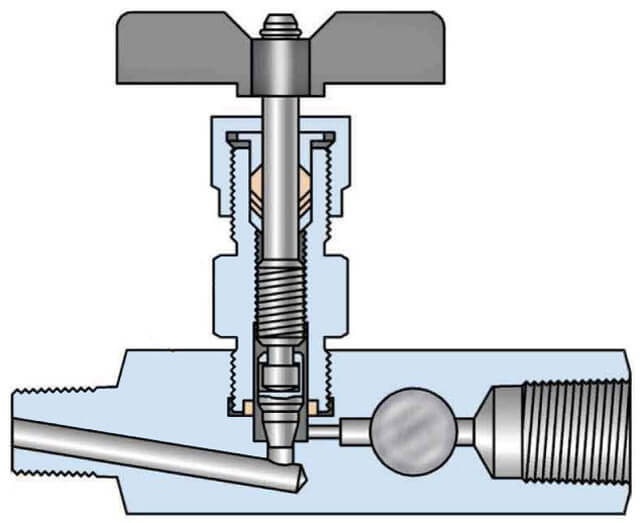

Since the passage is very narrow, it is not recommended to install the needle device when solving the problem of how to regulate the temperature of the battery, since its heat dissipation is greatly reduced.
You can increase it as follows:
- removing the valve;
- doubling the number of sections;
- by placing a device that has twice the number of couplings.
Regulating valves for radiators
In order to manually adjust the operation of heating devices, special valves are used. Such cranes are realized with a straight or angled connection. The procedure for regulating radiators using these devices in manual mode is as follows.
When the valve is turned, the shut-off cone is raised or lowered. In the closed position, the heating medium flow is completely shut off. Moving up or down, the cone regulates more or less the amount of circulating water.
Due to this principle of operation, these valves are also called "mechanical temperature controllers". They are installed on the batteries on the thread, and they are connected to the pipes with fittings, most often of the crimp type.
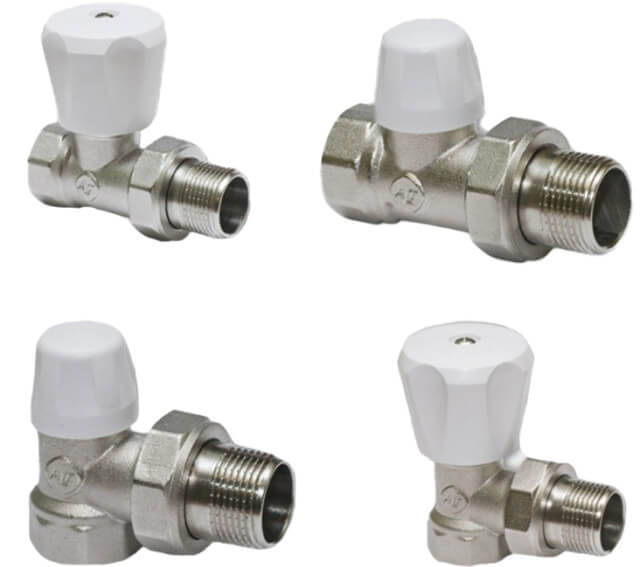

The control valve used for heating devices has the following advantages:
- the device is reliable, it is not dangerous for blockages and fine-grained abrasive particles present in the coolant - this applies exclusively to high-quality products in which the valve cone is made of metal and carefully processed;
- the product has an affordable cost.
The control valves also have disadvantages - each time the device is used, its position has to be changed manually and for this reason it is quite problematic to maintain a stable temperature regime.
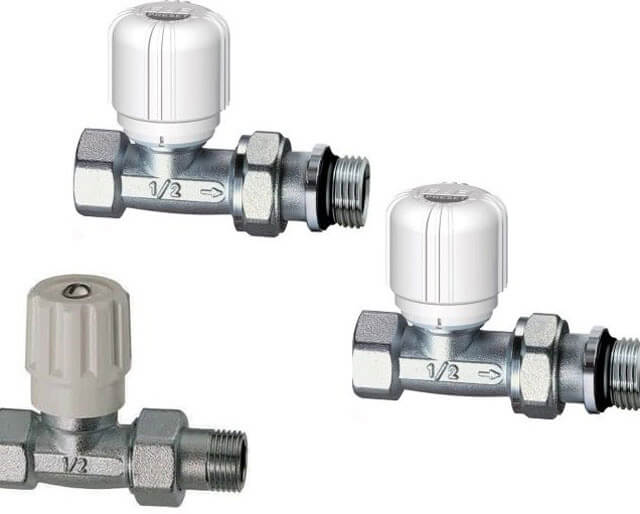

For those who are not satisfied with this order, and he is thinking about how to regulate the temperature of the heating battery by another method, the use of automatic products is more suitable, which allows you to control the degree of heating of radiators.
Battery Regulation Options
You can regulate the temperature of the coolant in heating devices:
- manually using ball valves, cone valves;
It should be borne in mind that ball valves have two operating positions "Open-Closed", and attempts to install them in an intermediate mode lead to rapid wear of the device.


Figure 1 - Types of ball valves


Figure 2 - Cone valve for radiator
- using thermostats of various types: mechanical (equipped with a thermostatic head, in which a bellows is a sensitive element, and control, in particular, adjustment is carried out manually); electrical (similar in principle to mechanical models, but the device automatically changes the position of the valve to ensure the specified temperature level); electronic (programmable, in which information about the monitored parameters comes from sensors, and the adjustment is carried out smoothly according to a given program).
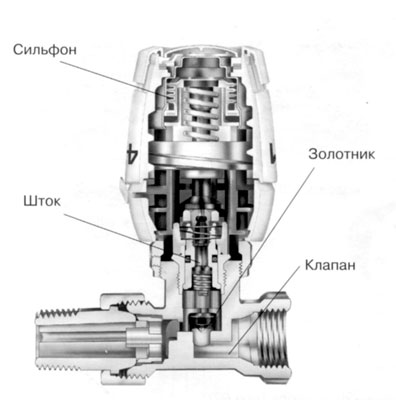

Figure 3 - Mechanical thermostat


Figure 4 - Electronic regulator for batteries
When choosing the temperature regime for a particular room, the following factors must be taken into account: the location of the room (corner, private, floor) and the frequency of its use; the number of openings through which heat leaks are possible (windows, doors); availability and quality of thermal insulation of enclosing structures and windows; outside air temperature; frequency and intensity of ventilation.
Battery regulation with thermostat
To ensure the constant maintenance of the set temperature in the room, they use thermostats for radiators (thermostats). These devices also have other names - thermostatic valve, thermostatic valve, etc. There are many names, but they all refer to one product.
The thermo-valve and thermo-valve are the lower part of the device, and the thermo-head and thermo-element are the upper part. Most of these products operate without power supplies. The exception is models with a digital display, in which batteries are placed in the thermostatic head. They often do not have to be changed, since the current consumption is insignificant.
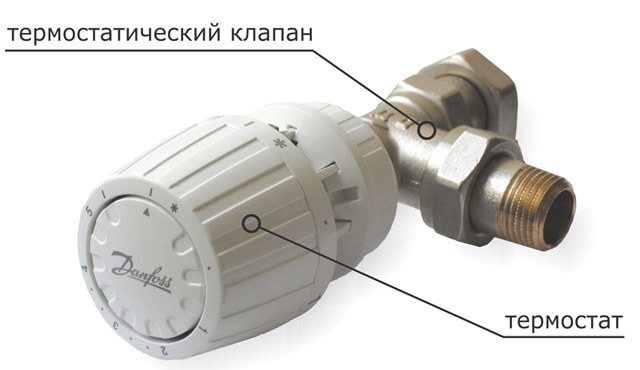

The radiator thermostat consists of several components:
- a thermostatic valve, which is called a "body", "thermo valve", "thermal valve";
- thermostatic head or "thermostatic element", "thermoelement", "thermal head".
The body (valve) is made of metal, usually of bronze or brass. Outwardly, its design resembles a manual valve. Many manufacturers make the lower part of the radiator thermostat unified. This means that different types of heads can be mounted on one housing, regardless of their manufacturer.
Thus, it is possible to install a thermoelement with different control on the thermal valve - manual, mechanical or automatic, which is very convenient. If there is a desire to change the adjustment method, there is no need to buy the entire device, you just need to install a different thermostatic element.
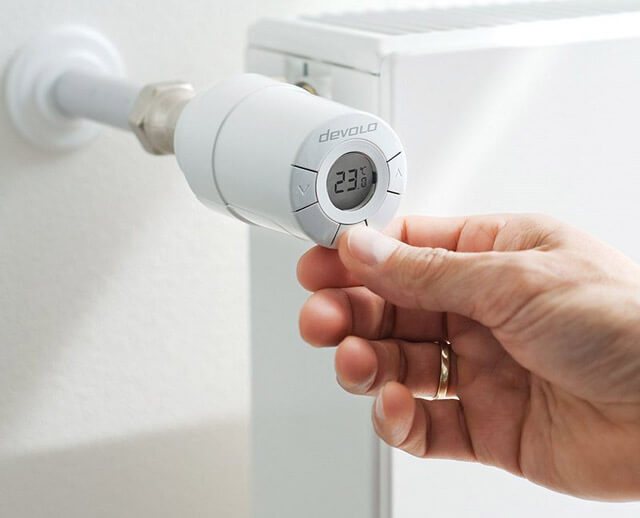

Automatic regulators differ in the principle of influencing the locking mechanism. In a hand-held device, its position is changed by turning the handle. As for automatic models, they usually have a siphon that puts pressure on a spring-loaded mechanism. In electronic products, the processor controls the workflow.
The bellows is the main element of the thermoelement (thermal head). It looks like a small sealed cylinder with a liquid or gas inside. Both of these substances have a common property - their volume depends on temperature. When heated, gas and liquid begin to increase significantly in volume and thereby stretch the cylinder.
The bellows, when pressure is applied to the spring, shuts off the coolant flow. When the volume of the working medium decreases as it cools, the spring rises and thereby the fluid flow increases, and the radiator heats up again. Due to the use of such a device, depending on its calibration, the set temperature can be maintained with high accuracy - up to one degree.
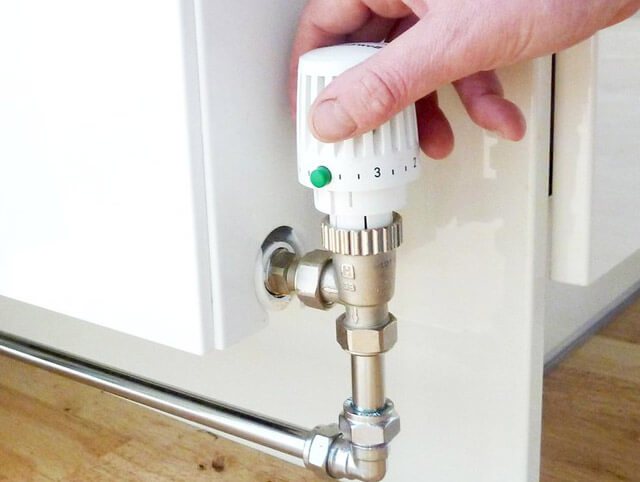

Before using a radiator, everyone who decides to purchase a thermostat for it must decide what kind of temperature control it should have:
- manual;
- auto;
- with built-in or remote sensor.
There are also models on sale for one-pipe and two-pipe systems, with housings made of different metals.
Application of three-way valves
One way to regulate heating radiators is to use a three-way valve. True, it is rarely used. Despite the fact that it is designed to solve other problems, such its application is possible.
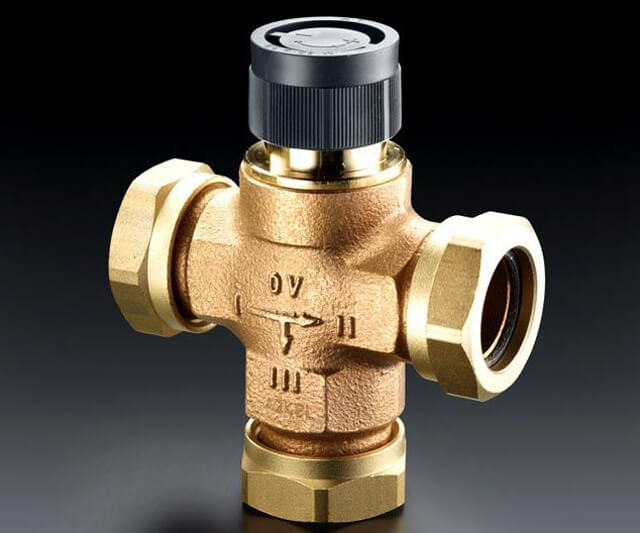

A three-way valve is mounted at the junction of the bypass with the supply pipe to the heating battery. To stabilize the temperature of the working medium, it is necessary that it be equipped with a thermostatic head.
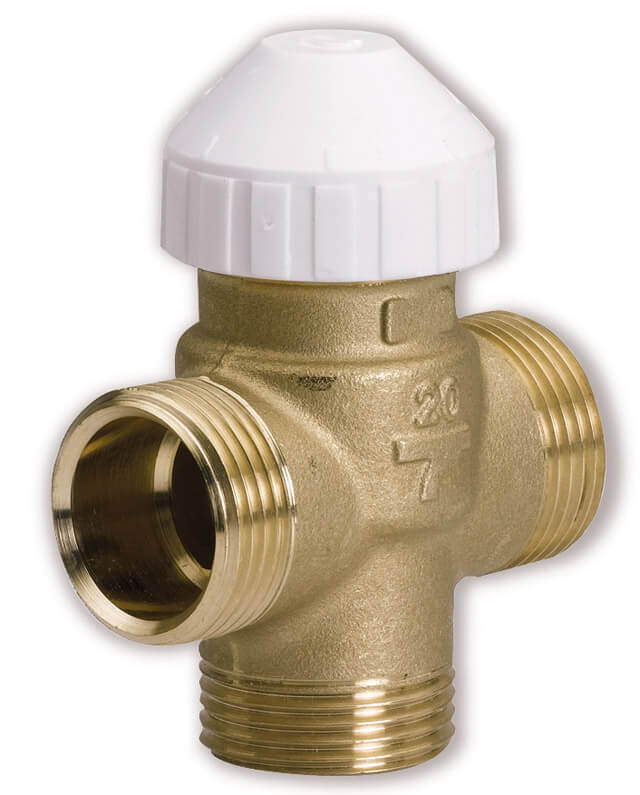

When the temperature near the head of the three-way valve becomes higher than the set parameter, the flow of fluid to the radiator is shut off - it is directed to the bypass. After the coolant has cooled down, the valve starts to operate in the opposite direction, and the battery heats up again. This connection method is usually implemented in one-pipe heat supply systems, and with vertical wiring.
Summarizing
It is possible to regulate radiators using several types of devices, but experts believe that the best solution would be to use special control valves. Such products are manual taps and automated products - thermostats, and only in some cases can a three-way valve with a thermal head be used.
In high-rise apartments with centralized heating, it is better to give preference to control valves or a three-way valve. As for individual heat supply systems, then the problem with how to reduce the temperature of the coolant in the heating battery is solved with the use of thermostats.
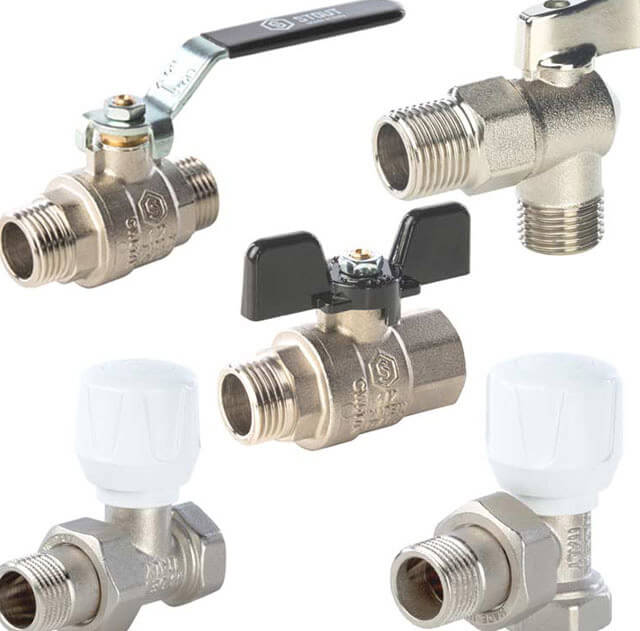

If the owner of the apartment still prefers automatic regulation of the radiators, then a filter should be installed before the thermostat - it will retain most of the various impurities.







